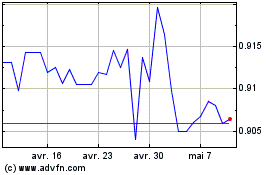Dollar Paring Losses After Initial Drop Following Fed Rate Hike
14 Juin 2017 - 4:31PM
RTTF2
The dollar briefly spiked lower against all of its major rivals
Wednesday afternoon, but has since pared its losses. The sharp move
followed today's announcement from the Federal Reserve, which
raised its benchmark interest rate for the third time in three
months despite signs the U.S. economy has cooled off in 2017.
The Federal Open Market Committee voted to raise fed funds to
between 1% and 1.25% and will start "gradual" shrinking of its $4.5
trillion balance sheet "this year."
Their so-called 'dot plot' shows one more rate hike in 2017 and
three more in 2018, but the Fed's accompanying statement offered
little indication they plan to raise interest rates again this
summer.
Policy makers say they are "monitoring developments closely,"
meaning they are likely wait for confirmation that recent economic
weakness is "transitory."
Retail sales in the U.S. unexpectedly decreased in the month of
May, according to a report released by the Commerce Department on
Wednesday. The Commerce Department said retail sales fell by 0.3
percent in May after climbing by an upwardly revised 0.4 percent in
April.
The drop in sales surprised economists, who had expected sales
to inch up by 0.1 percent compared to the 0.3 percent increase
originally reported for the previous month.
Reflecting a steep drop in energy prices, the Labor Department
released a report on Wednesday showing a modest decrease in U.S.
consumer prices in the month of May. The report said the consumer
price index edged down by 0.1 percent in May after rising by 0.2
percent in April. Economists had expected prices to come in
unchanged.
The dollar briefly dropped to a low of $1.1294 against the Euro
Wednesday afternoon, but has since bounced back to around
$1.1250.
Eurozone industrial production increased for the second straight
month in April, in line with expectations, data from Eurostat
showed Wednesday.
Industrial production climbed a seasonally adjusted 0.5 percent
month-over-month in April, faster than the 0.2 percent rise in
March, which was revised from a 0.2 percent drop reported earlier.
The figure also matched consensus estimate.
Employment hit a record high in both the euro area and the EU28
in the first quarter of the year amid sustained growth in the
figures, preliminary data from Eurostat showed Wednesday. The
number of employed totaled a seasonally adjusted 154.8 million for
the Eurozone and 234.2 million for the EU28 during the first
quarter. Both figures were the highest ever.
Germany's consumer price inflation slowed to a six-month low in
May, as initially estimated, data from the statistical office
Destatis showed Wednesday. Inflation eased to 1.5 percent in May
from 2 percent in April. This was the lowest since November, when
the rate was 0.8 percent.
The buck slipped to a low of $1.2817 against the pound sterling
Wednesday afternoon, but has since rebounded to around $1.2775.
The UK unemployment rate remained unchanged at the lowest level
since 1975, but wage growth remained subdued squeezing household
spending.
The ILO jobless rate came in at 4.6 percent in the three months
to April, the same rate as seen in the three months to March, data
from the Office for National Statistics showed Wednesday. The rate
came in line with economists' expectations.
The greenback briefly sank to over a month and a half low of
Y108.685 against the Japanese Yen this afternoon, but has since
bounced back to around Y109.325.
Japan's industrial production expanded as initially estimated in
April, final data from the Ministry of Economy, Trade and Industry
showed Wednesday. Industrial output grew 4 percent month-on-month
in April, in line with the preliminary estimate published on May
31. Production had declined 1.9 percent in March.
US Dollar vs CHF (FX:USDCHF)
Graphique Historique de la Devise
De Mar 2024 à Avr 2024

US Dollar vs CHF (FX:USDCHF)
Graphique Historique de la Devise
De Avr 2023 à Avr 2024
